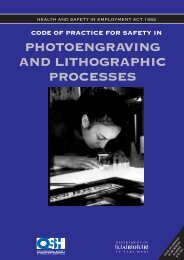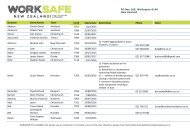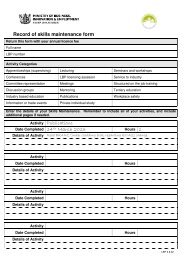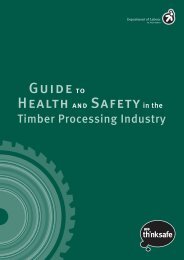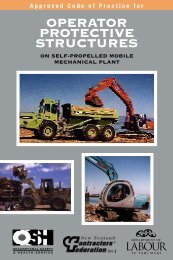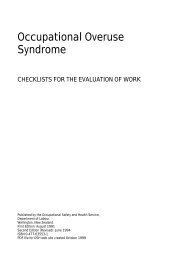Confined spaces entry - Business.govt.nz
Confined spaces entry - Business.govt.nz
Confined spaces entry - Business.govt.nz
Create successful ePaper yourself
Turn your PDF publications into a flip-book with our unique Google optimized e-Paper software.
FACTSHEET<strong>Confined</strong> Spaces: Planning Entry and Working Safely in a <strong>Confined</strong> SpaceThe Department of Labour accepts Australian Standard AS 2865:2009 <strong>Confined</strong> Spaces as the current state of knowledge onconfined space <strong>entry</strong> work.DOL 12040 OCT 12<strong>Confined</strong> <strong>spaces</strong> – serial killer<strong>Confined</strong> <strong>spaces</strong> have been likened to a serial killer. Year afteryear, people die when entering confined <strong>spaces</strong> to carry outwork. In some cases, multiple fatalities occur when would-berescuers enter the space and become victims themselves.Consider these cases in New Zealand:• 2008: A man was killed when he was engulfed in a silocontaining sand.• 2003: Two men were hospitalised after inhaling hydrogensulphide. One man was cleaning inside a tank that previouslystored a substance for cultivating mushrooms. When helost consciousness, the second man climbed in to rescuehim before also losing consciousness.• 1999: Three men died from lack of oxygen inside a sewermanhole.• 1998: A man drowned in slurry after being suffocated byfermentation fumes in a tank used to mash pig feed.• 1997: A winemaker inspecting a vat was suffocated byfumes from fermenting wine.• 1997: A man steam cleaning the inside of a fuel tank diedfrom lack of oxygen.About this fact sheetBecause work in a confined space is so hazardous, it iscovered by an Australian standard: AS 2865-2009 <strong>Confined</strong><strong>spaces</strong>.This leaflet will give you a brief overview of the requirementsand procedures in the Standard. It is not a substitute for theStandard itself.Anyone who carries out confined space work needs to befamiliar with the Standard, and should have had specialisttraining as well.What is a confined space?A confined space is defined as an enclosed or partiallyenclosed space that is not intended as a place of work.It is liable to have an atmosphere that contains harmfulcontaminants or not contain a safe oxygen level. It mayhave contents that could cause engulfment. It may haverestricted means for <strong>entry</strong> and exit.Examples include: storage tanks, tank cars, process vessels,boilers, silos, pits, pipes, sewers, shafts, ducts, shipboard<strong>spaces</strong>.What does the Standard require?The standard follows the approach of the Health and Safetyin Employment Act 1992. It requires employers (or persons incontrol of the place of work) to:• Identify the hazards associated with working in theconfined space.• Assess the risks (i.e. determine if the hazards aresignificant).• Control the risks by:»»elimination;»»isolation;»»minimisation; and»»use of personal protective equipment.Identifying and assessing hazardsThe Standard gives detailed information on hazardidentification and risk assessment.Some of the hazards of confined <strong>spaces</strong> include:• Oxygen-deficient atmospheres, which can cause braindamage and death.»»Oxygen deficiency can be caused by rust, fire, absorptionby grain or soils, consumption by bacteria, anddisplacement by another gas.• Toxic atmospheres, containing gases, vapours, dusts orfumes that have poisonous effects on the body. Cleaning,painting or welding may produce dangerous vapours orfumes.• Flammable or explosive atmospheres, containing flammablegases, vapours or dusts which could be ignited by a sparkor open flame. The risk of explosion or spontaneouscombustion is increased if an oxygen-enriched atmosphereexists (where the oxygen content is greater than 23.5%).• Engulfment – workers can be trapped or buried by dry bulkmaterials such as grain, sand, flour, fertiliser and sawdust.• Operation of moving parts, e.g. being trapped or crushedby augers, mixers, agitators or conveyor belts).• Uncontrolled introduction of steam, water, or other gas orliquid.• Other hazards could result from the work being done, e.g.noise, extremes of temperature, radiation, manual handlingand falls.The Department of Labour takes no responsibilityfor the results of any actions taken on the basis ofthis information, or for any errors or omissions.www.dol.<strong>govt</strong>.<strong>nz</strong>0800 20 90 20
Controlling the risksThe control measures should be applied in the order givenearlier (beginning with elimination, followed by substitution,etc.) These are summarised as follows:Can work be done without <strong>entry</strong> to the confined space?Always, as a first step, check to see if the work can be donewith equipment from outside the confined space. The goldenrule is: Don’t go in if you don’t have to.Isolate contaminants and moving parts.Prevent accidental introduction of materials, e.g. steam,water, through piping, ducts, vents, etc. De-energise, lockoutor tagout machinery.Clean and purge the confined space if necessary.Use a suitable cleaning method to remove harmful solids orsludges. Purge to remove harmful gases or vapours.WARNING: Never use oxygen to purge a confined space: thiscan create a fire and explosion hazard.Test the atmosphere for oxygen.Use a suitable detector to determine whether the confinedspace contains a safe oxygen level for breathing.Where possible, atmospheric testing should be carried outwithout entering the confined space.Test the atmosphere for toxic and combustiblecontaminants.Test for toxic contaminants (e.g. hydrogen sulphide, methane,carbon monoxide) and combustible contaminants(e.g. petroleum vapours).You need to use appropriate detection equipment, whichshould be correctly calibrated at regular intervals.Ventilate the confined space if necessary.Ventilate the confined space by using a fan, by blowing airin with a compressor, or by opening more manhole coversor other <strong>entry</strong> or exit points. Then test again for levels ofoxygen and other gases to ensure that contaminants arereduced to below the Workplace Exposure Standard, or asafe level.Select appropriate breathing apparatus if necessary.If the space can’t be ventilated, or if the work willcontaminate the atmosphere (e.g. hot work, painting, sludgeremoval), a suitable self-contained breathing apparatus orsupplied-air respirator should be used.Select personal protective and safety equipment.As well as breathing apparatus, this could include items suchas safety helmet, gloves, hearing protectors, safety harnessand lifeline.Personal protective equipment should only be used eitheras a last resort, or when all other control measures fail tocontrol the risk, or in an emergency response.Issue a written authority for <strong>entry</strong> to work.The employer or person responsible for the work should issuea written authority – or confined space <strong>entry</strong> permit – asdescribed in the Standard. Essentially, this permit is a safetychecklist to make sure nothing is overlooked.Where necessary, have a trained stand-by person outsidethe confined space.The stand-by person’s role is to monitor the safety of theperson working inside the confined space and to take actionif an emergency arises.Ensure there is a reliable system of communication –by voice, radio, hand signals, hard-wired communication, etc.Monitor and maintain control measures.Test the air in a confined space constantly as oxygen and gaslevels in a confined space can change quickly. Be alert for anychange in conditions.If conditions change, evacuate the confined space.Where necessary, there should be a system for getting aworker out of the space quickly if anything goes wrong. Thiscould include using a safety harness and lifeline attached toa tripod.For further informationThis fact sheet is a brief summary only of the Standard, and does not provide all the information required for safe working ina confined space.For more information see:• AS 2865-2009 <strong>Confined</strong> <strong>spaces</strong>. (Available from Standards Australia).• Safe Working in a <strong>Confined</strong> Space.The Department of Labour takes no responsibilityfor the results of any actions taken on the basis ofthis information, or for any errors or omissions.www.dol.<strong>govt</strong>.<strong>nz</strong>0800 20 90 20


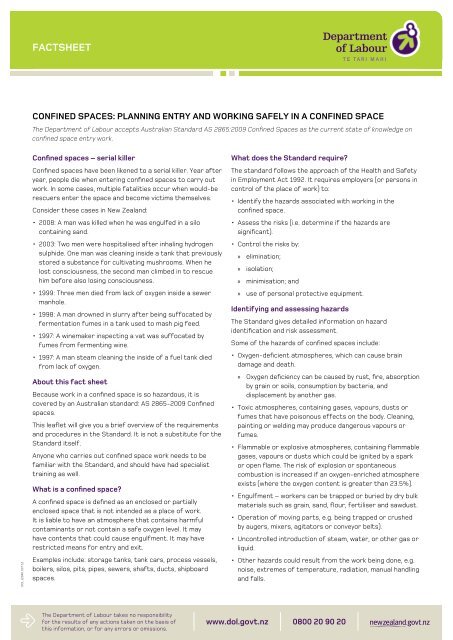

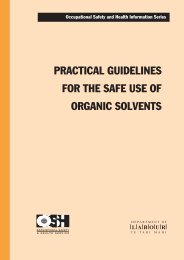
![Task analysis worksheet [161 KB PDF] - Business.govt.nz](https://img.yumpu.com/51400981/1/190x135/task-analysis-worksheet-161-kb-pdf-businessgovtnz.jpg?quality=85)

